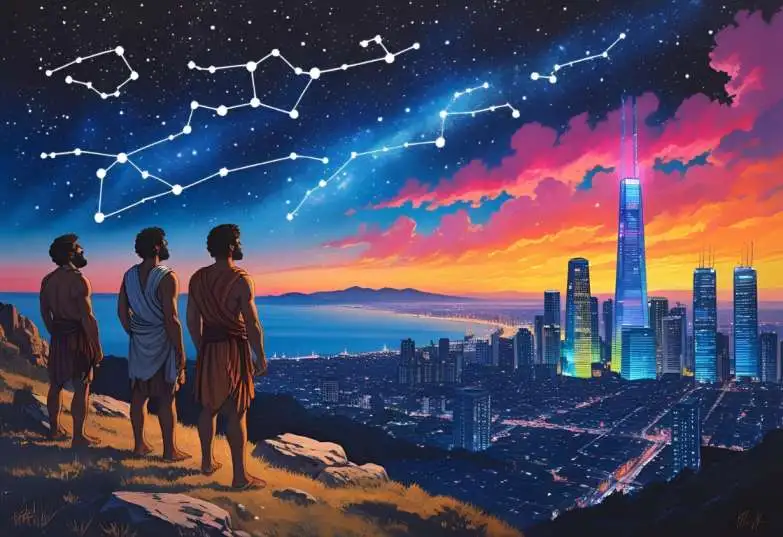Introduction
Did you know that 83% of the global population can no longer see the Milky Way due to light pollution?
Have you ever looked up at the night sky, only to find it drowned in artificial light? Stars that once sparkled in abundance are now hidden behind the bright glow of cities. This growing issue, known as light pollution, is affecting not just our view of the cosmos but also wildlife, human health, and the environment.
One creative and educational way to spread awareness, especially in schools or awareness campaigns, is through light pollution drawing. Whether you’re a student working on a project or a nature lover trying to make a difference, using art to highlight the impact of light pollution can be powerful and easy to understand. A simple drawing can illustrate the contrast between a natural night sky and a city sky filled with glare.
In this blog, you’ll discover what light pollution is, how art plays a role in raising awareness, and easy steps to create your light pollution drawing. You’ll also find drawing ideas and examples that anyone, from kids to eco-conscious artists, can try. Let’s explore how your pencil and creativity can help reclaim the stars.
Downloadable for Students & Teachers:
Get our Light Pollution Awareness Classroom Handout (PDF)—it includes a summary, infographic, and quiz—perfect for school use. Teachers can also use trusted guides like National Geographic’s light pollution resource to support classroom discussions and art-based projects.
Table of Contents
What Is Light Pollution and Why Should You Care?
What Is Light Pollution?
Light pollution happens when artificial lighting, like streetlights, billboards, or home lights, spills into places where it’s not needed. This bright glow makes it hard to see stars in the night sky. In big cities like Delhi, Mumbai, or Bengaluru, people often see just a few stars, even on a clear night. This is not because the stars are gone, but because too much man-made light is drowning them out.

There are different types of light pollution:
- Skyglow – the orange or white haze over cities
- Glare – bright, harsh lights that hurt your eyes
- Light trespass – light entering areas where it’s not wanted
- Clutter – too many lights close together, causing confusion
Light pollution is not just a problem for astronomers. It affects animals, birds, and even humans. Migrating birds get lost, turtles can’t find the sea, and people may struggle with poor sleep due to excessive light exposure at night.
Understanding this issue is the first step in creating a meaningful light pollution drawing that speaks to real problems. According to the International Dark-Sky Association, light pollution is a growing global issue that affects astronomy, ecosystems, and public health.
Why Is It a Problem?
- You might think lights make life safer, but too much light can cause harm.
- Light pollution disrupts natural rhythms.
- Humans and animals follow a body clock called the circadian rhythm, which needs darkness to function properly. When cities stay bright all night, this balance is disturbed.
In India, many urban areas never get fully dark. This constant glow leads to:
- Wasted energy, especially from poorly designed streetlights
- Health issues like sleep disorders, stress, and even depression
- Harm to ecosystems, as many insects and birds rely on natural night-time cues
Light pollution also affects cultural and spiritual connections with the night sky. For centuries, people have found peace and inspiration by watching the stars. Now, that experience is fading for urban families and children.
By creating or supporting a light pollution drawing, you help others understand these problems in a simple yet visual way. Art becomes a tool to show the cost of too much light and the beauty we risk losing.
Satellite data from NASA Earth Observatory – Night Lights further supports this by mapping how artificial light impacts human activity, energy consumption, and environmental systems across continents.
“ISRO’s Bhuvan portal allows users to view night-time satellite imagery over India, revealing how light pollution has intensified around cities like Delhi, Mumbai, and Bengaluru.”
Light Pollution Drawing as a Powerful Educational Tool
How Art Can Raise Awareness
Not everyone reads science articles or watches documentaries, but almost everyone can connect with a powerful image. That’s why light pollution drawing can be such an effective way to raise awareness, especially among students, children, and families. A well-made drawing can show the difference between a starlit sky and a polluted one better than words alone.
Art is a universal language. It doesn’t matter if you’re in Kolkata, Pune, or a small village—when someone sees a drawing of a dark sky full of stars compared to a bright, empty city sky, they understand what’s being lost. For students, it’s also a fun way to learn about real environmental issues.
Teachers can use light pollution drawings in classrooms to explain science and nature creatively. NGOs and eco clubs can use them in awareness drives or social media campaigns. Even small exhibitions in schools or local parks can spark conversations.
Art can move people, and in this case, it can move them to care about saving the night sky.

Real-Life Examples from India and Worldwide
Across India and around the world, people are already using light pollution drawing to educate others. For example, many schools include poster-making competitions during Earth Day or Environmental Week. Students often create drawings that show one side of a city with too many lights and another side with a peaceful, starry sky.
In Pune, a local astronomy group invited children to draw what the night sky “should” look like. The results were beautiful and eye-opening. Some students even added animals like owls and bats to show how light pollution affects wildlife, too.
Globally, campaigns like “International Dark Sky Week” encourage artists to submit drawings, paintings, or digital art that highlight the loss of natural darkness. These works are shared online to reach thousands of people. You can even contribute your drawings or night sky observations to global citizen science projects like Globe at Night, which maps light pollution worldwide.
Whether it’s a simple sketch or a detailed artwork, a light pollution drawing can start a conversation. It helps people see the problem, and once they see it, they might care enough to make a change.

How to Create an Effective Light Pollution Drawing
Materials and Concepts for Beginners
You don’t need fancy tools to start a light pollution drawing. Just a pencil, eraser, black sketch pen, and some colored pencils or crayons are enough. If you’re doing it digitally, free apps like Autodesk Sketchbook or iPaint X can work on a mobile phone or tablet.
The idea behind the drawing is simple: show the difference between a natural night sky and one polluted by artificial light. You can divide your paper into two parts. On one side, draw a quiet village or forest with stars, moonlight, and maybe some owls or fireflies. On the other side, draw a bright city with glowing buildings, streetlights, and empty skies.
Keep the color contrast clear. Use darker shades (like blue or black) for the natural sky and yellow-white tones for the light-polluted sky. You can even add a message like “Save Our Stars” or “Let the Night Be Dark.”
The most important thing is to tell a story through your art. Your drawing should make people pause and think.
Step-by-Step Guide to Drawing Light Pollution
Here’s a simple way to create your light pollution drawing:
- Start with a rough sketch – Divide your paper in half or use a before-and-after style layout.
- Choose your scenes – For the “dark sky” side, draw trees, stars, the moon, and peaceful surroundings. For the “polluted sky” side, show tall buildings, car headlights, and neon boards.
- Add details – Show how light travels upward in the city scene. Add birds flying away or confused animals to reflect the real impact.
- Use color wisely – Make the starry side calm and cool. Use bright, unnatural colors on the other side to show discomfort.
- Write a short message – A simple caption can help your viewer understand the meaning instantly.
- This kind of drawing is great for school projects, eco-club contests, or social media awareness.
- Many students in India have used this method in poster-making competitions and even won prizes.
Remember, your light pollution drawing doesn’t need to be perfect. It just needs to make people see what they’re missing in the night sky.

Ideas and Inspiration for Light Pollution Drawing Projects
Drawing Ideas for Students and Kids
If you’re a student or a young artist, there are many simple and fun ways to create a light pollution drawing. You don’t need to be a professional. Just focus on the message your drawing will share.

Here are some beginner-friendly ideas:
- Before and After Scene: Draw one half of your paper with a clean, starry sky. The other half shows a city filled with light—no stars, just glare.
- Save the Night Sky Poster: Make a poster that says “Let the Stars Shine” or “Switch Off for Nature,” along with a drawing of a star-filled village and a bright, noisy city.
- Animals Affected by Light: Show an owl, turtle, or bat getting confused by too much light. Add a simple message like “Too Much Light Hurts Wildlife.”
These drawings are great for school competitions, science fairs, and Earth Day events. They also help you learn how real-world problems like light pollution can be explained visually. A good light pollution drawing speaks louder than words.
Concepts for Eco Artists and Professionals
If you’re an eco-conscious artist, designer, or teacher, your light pollution drawing can go deeper. Instead of just showing the problem, try to tell a bigger story.
Here are some thoughtful ideas:
- Contrast Art: Use high contrast between dark and light to show the damage of urban lighting. You can draw a child reaching for stars on one side—and a blank, glowing sky on the other.
- Cultural Connection: Show how people in ancient India watched constellations for farming, prayer, or storytelling—and how that connection is fading today.
- Street-to-Sky Timeline: Create a drawing that shows a streetlight turning on and, above it, fewer and fewer stars appearing. A timeline like this can make the message very clear.
These ideas can be used in awareness campaigns, NGO presentations, or shared on Instagram, Pinterest, or local exhibitions. A well-crafted light pollution drawing can spark conversation, encourage questions, and make people care about the invisible problem above their heads.

Conclusion: Use Art to Light Up Awareness, Not the Sky
The night sky belongs to everyone.
But due to growing light pollution, we are slowly losing it. Many people, especially in cities, have never seen the Milky Way or even more than a few stars. This loss doesn’t just affect stargazing. It affects nature, human health, energy use, and our emotional connection with the world around us.
That’s why a simple light pollution drawing can be such a powerful tool. Whether you’re a student creating a poster for school, an artist spreading awareness through visuals, or just someone who cares about the environment, your art can make a real difference. It can open eyes, start conversations, and inspire action.
The best part? You don’t need to be a professional. Just grab a pencil, imagine a peaceful night sky, and draw what’s missing from your world. One drawing might not stop light pollution, but it can light the way for change.
So go ahead—create your light pollution drawing, share it, and help bring back the stars.
FAQ: Light Pollution Drawing
Q: What is a light pollution drawing?
A: A light pollution drawing is an artwork that visually shows the impact of artificial lighting on night skies, often used to raise awareness or educate others.
Q: How can a light pollution drawing help spread awareness?
A: A light pollution drawing helps by showing the difference between a natural starry sky and a sky affected by city lights, making the issue easier to understand visually.
Q: What are some easy ideas for a light pollution drawing?
A: You can create a before-and-after sky, show animals affected by bright lights, or draw a peaceful night scene compared to a city full of glare.
Q: Which tools do I need for making a light pollution drawing?
A: Basic tools include pencils, crayons, black pens, and paper. Digital artists can use apps like Sketchbook or ibisPaint to create light pollution drawings.
Q: Why are students creating light pollution drawings in schools?
A: Schools use light pollution drawings to teach students about environmental problems and encourage creativity during poster competitions or science fairs.
Q: How can I use a light pollution drawing in a project?
A: Add it to science fair posters, awareness campaigns, or presentations on environmental issues. It adds visual impact to your project on pollution or astronomy.
Q: Where can I share my light pollution drawing online?
A: You can share it on social media platforms, eco-art forums, NGO campaigns, or even submit it during events like International Dark Sky Week.
Want to learn more about Light Pollution Drawing?
- How to Make a Light Pollution Drawing for a School Project (Step-by-Step Guide)
- Top 5 Light Pollution Drawing Messages for Students & Artists: Raise Awareness with Art
- Light Pollution Drawing with Animals: Ideas Featuring Owls, Turtles & Bats
- Dark Sky Movement Explained Through Light Pollution Drawings: →
- Simple vs. Advanced Light Pollution Drawings: What’s the Difference? → will be coming to our site soon!
Conclusion: Draw the Change You Want to See
Light pollution is silently erasing our cosmic heritage, but through art and action, we can reclaim the night. By creating light pollution drawings, you’re not just making art—you’re starting conversations and inspiring change.
For a deeper perspective, watch Paul Bogard’s TED Talk on why we need darkness and how losing it affects us all.
Your Next Steps:
- Pick up your sketchbook and draw the stars that light pollution has stolen. Share your artwork, start a conversation, and be a voice for the night sky.
- Post your artwork online and spark conversations about light pollution.
- Take action to reduce light pollution in your area.
The night sky belongs to all of us—let’s preserve its beauty, one drawing at a time. Share your art and inspire change!
Need a Summary or Quiz for Class?
- 📥 Download Now
- ✅ Get the free PDF: drawing ideas, summary, and quiz
- 👉 Click here to download your copy
Quick Light Pollution Facts
- 83% of the global population lives under light-polluted skies (Science Advances).
- NYC’s light dome is visible from over 100 miles away.
- France has nationwide laws requiring businesses to turn off lights after 1 AM.
- For inspiration, explore real examples of light pollution drawings on Pinterest shared by students and artists.
“We are drowning the night in light, and the consequences are more than just poetic loss.” —Paul Bogard, The End of Night. To buy from Amazon, click here
🛒 Disclosure: As an Amazon Associate, I earn from qualifying purchases at no extra cost to you. Your support helps keep this site running. Thank you!

